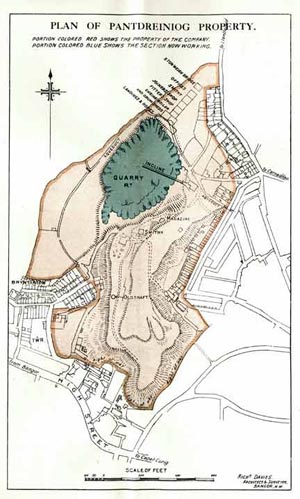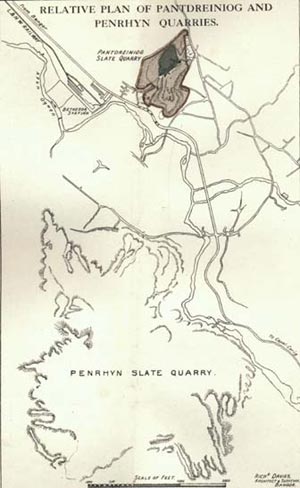The
History of Quarrying
STRICTLY PRIVATE - NOT FOR CIRCULATION
Re-opening of a Valuable Slate Quarry
PARTICULARS
OF A PROMISING
BRITISH ENTERPRISE
The
Pantdreiniog Slate Quarry,
Bethesda, North Wales,
adjacent to the well-known
Penrhyn Slate Quarries
The option to acquire a 50
Years' Lease upon this Property has been
secured by
MINERALS, OIL AND GENERAL EXPLORATION
COMPANY, LIMITED
London Office (pro tem):- 20,
BUCKLERSBURY, LONDON E.C.
Secretary. C.H. HARWARD.
Local Agent and Office:
W.J. PARRY, COETMOR CHAMBERS, BETHESDA,
NORTH WALES

PANTDREINIOG.
GENERAL DESCRIPTION OF
THE QUARRY.
SITUATION. - This Quarry is situated
at Bethesda, in the Parish of Llanllechid,
County of Carnarfon, and less than one mile
from L. & N. W. Railway Station at
Bethesda.
EXTENT. - The Estate comprises about
25 acres, part of which is Agricultural Land
and the remainder is used for Quarrying
purposes.
GEOLOGICAL POSITION. - The Slate
beds traversing this property belong to the
well?known Cambrian formation and consist of
two valuable beds known as the Blue and
Purple slate rocks, in which several of the
principal quarries in North Wales are
situated.
The two beds are fully exposed at the
Pantdreiniog Quarry and immense quantities
of marketable slates have from time to time
been quarried therefrom.
This Quarry has been worked for more than
80 years, and the works are now down to a
depth of 75 yards on the slate veins that
have been worked to a depth of 300 yards in
the Penrhyn Quarries.
The Blue vein is situated on the
North-West side of the Quarry where an
extensive body of good rock is available for
quarrying after certain developments have
been carried out. This is proved by a tunnel
which has been driven from the present open
quarry, at a depth of over 100 feet from the
surface of the Western boundary of the
Estate, a distance of 85 yards, practically
the whole of which is in rock of excellent
quality.
The Purple vein is on the South-East side
of the quarry opening, from which large
quantities of slates have also been taken.
This bed is of great extent and is proved by
a tunnel 160 yards long driven in a
South-Westerly direction at a depth of 62
feet above the lowest gallery in the present
open quarry, about 70 yards of which is
driven in rock of good quality.
PRESENT STATE OF DEVELOPMENT. - The
Quarry is well equipped with all suitable
machinery and plant necessary for its proper
working, comprising Two Hauling Engines,
with Eight Aerial Ropeways, Two Locomotives,
Twenty-two Tram Waggons, Twenty Quarrymen's
Working Sheds, Tram Lines, Two Powerful
Hydraulic Pumps, Five-on Weigh Bridge,
Weighing Machine, and all the necessary
buildings for the proper carrying out of the
present proposed work.
GENERAL CONCLUSIONS. - The property
contains slate beds of considerable extent
and of good colour and texture.
The facilities for working compare
favourably with the conditions in other
quarries which have been worked
successfully.
The accommodation for workmen is ample
and convenient.
The terms of the lease compare favourably
with other quarries, and the cost of transit
being only 1s. per ton to the Railway
Station must be considered low.
The fact that quarry workings are drained
by means of hydraulic pumps is a valuable
asset to this property, and having regard to
the extent of the slate beds and the
facilities for working, it will confidently
justify the proposed expenditure, which, if
judiciously applied, should result in
adequate profits being returned.
PAST HISTORY OF THE QUARRY. - The
Pantdreiniog Slate Quarry was first opened
up in or about the year 1825, by local
people who knew that it was a continuation
of the Penrhyn Quarry Slate Vein.
It was purchased from these local owners
by a London gentleman of the name of Overend,
who in turn sold it direct or by his
representative to a Mr. Schwabe, who built
Glyn Garth, the present palace of the Bishop
of Bangor. Upon the death of this owner, it
was taken over by Overend, Gurney & Co.,
and successfully worked by them for some
years until they failed. It was placed on
the Market by the Liquidator and purchased
by a well-known Liverpool Builder, Mr. John
Williams, of Moss Bank, the father of the
late Lord Mayor of Liverpool, and was
successfully worked by him for nearly forty
years. Early in the nineties it was sold by
Mr. Williams to a Cardiff Company, who again
in 1903 sold it to a London Company formed
to provide employment for the Quarrymen who
were then out on strike from the Penrhyn
Quarry.
This London Company bought other Slate
properties as well, but not having
sufficient Capital to work them all, they
abandoned in 1912 the three properties they
had purchased, and Pantdreiniog was taken
over from them by the Trustees of the
Cefnfaes Estate, upon which Estate the
Quarry is situated.
Owing to the depression in the Slate
Trade the Trustees have delayed placing the
Property on the Market until now, but have
recently granted a 90 day option from July
1st, 1915, to a London gentleman to take a
Fifty-years Lease of the property upon
reasonable terms.
The right to exercise this option has
been secured by the Minerals, Oil &
General Exploration Company, Limited, of 20,
Bucklersbury, London, E.C.
The Property is part of the Cefnfaes
Estate and contains about 26 acres, together
with rights over other portions of the
Estate upon agreed terms.
EXPERT OPINION:-
| "A thoroughly
sound commercial undertaking. The
Slate is of high
grade and quality, and the Quarry
can be economically worked." |
It has been estimated that a Syndicate
formed with a Capital of £15,000 to work
the Pantdreiniog Quarry would show the
following results in three years:-
|
FIRST YEAR |
| Capital
Expenditure |
|
| Income |
|
| Loss |
|
|
|
|
SECOND YEAR |
| Income |
|
| Capital
Expenditure |
|
|
|
| Deduct:
From First Year's Loss |
|
| Profit |
|
|
|
|
THIRD
YEAR |
| Income |
|
| Capital
Expenditure |
|
|
|
| Profit |
|
|
|
| TOTAL PROFIT
FOR THREE YEARS |
|
THE ROOFING SLATES OF PANTDREINIOG
are widely used for roofing houses and
buildings of every description, and for such
purposes are equal to any that are produced;
the better kinds possessing all the
qualities necessary for protection against
rain, wind and storm.
PANTDREINIOG SLATE QUARRY.-The
Roofing Slates produced at this Quarry are World-renowned.
They are among the Most Durable and
Weather-Resisting Slates produced.
Special attention will be paid to the
production of Slate Slabs from this Quarry
to be used for
| Billiard Tables. |
Mantelpieces. |
| Brewery Vats. |
School Slates. |
| Cisterns. |
Stable Mangers. |
| Chemical Tanks. |
Switchboards. |
| Doorsteps. |
Tombstones. |
| Fire Hearths. |
Urinal Slabs. |
| Window Sills. |
|
WELSH SLATES.-Slate stands
prominently out among Roofing Materials,
and Welsh Slates are unsurpassed
throughout the World for the excellence
of their quality, The Pantdreiniog
Quarry possesses supplies for very many
years to come, blue and purple in colour,
and its Slate is among the hardest and
most durable. They are divided into
Three Qualities, Firsts, Seconds and
Thirds, and their lasting power is
proverbial.
The essential part of a house is its
Roof, and no part of a house is more
exposed to the destructive forces of the
elements than the Roof. Heat, Frost,
Wind, Rain, and even the atmosphere
itself all combine to attack the Roof of
a house. Welsh Slates successfully
withstand the attacks of all these
elements of nature.
SLATES versus TILES.-There are
good reasons for believing that when the
present disastrous war comes to an end,
and attention is being given to the
re?building of the enormous areas
devastated by the Ravages of War, that
for Roofing Purposes Slates will be
First and Tiles nowhere, and that the
demand for them will be reckoned by
Millions.
In past times many materials have
been used for roofs. The Ancients
sometimes roofed with Marble, Stone and
Metal. In these cases, the expense of
the material and the cost of labour was
a matter of no account, a great portion
of the cost of material and labour
having been borne by religious devotees.
In modern times, however, a very
different material has come relatively
into prominence for roofing purposes,
viz., Tiles. These are necessarily less
durable, and are more expensive, both
intrinsically and from the fact that
they require constant repair. The use of
Tiles for Roofing purposes may be based
upon the fact that they are more
artistic than Slates, but those who have
built with Tiles, in search of the
Artistic, have often found that they
have grasped at the shadow and lost the
substance. Tiles are by their nature, as
a rule fragile, and lack durability.
They are Artistic without doubt, but no
sane person would wear lawn as a
substitute for a waterproof, and Slates
will be the Roofing material of the
future.
VIEWS ON THE PROPERTY

Ref: XM1233/6
|